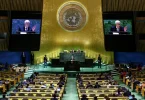Dr. Ramzy Baroud
Israel never learns from its mistakes. What Prime Minister Benjamin Netanyahu is trying to implement in Gaza is a poor copy of previous strategies used by other Israeli leaders. If these strategies had succeeded, Israel would not be in this position.
The main reason for Netanyahu’s lack of clarity about his real objectives in Gaza is that neither he nor his generals can determine the outcome of their futile war on the Strip — a war that has already killed tens of thousands of innocent civilians.
And no matter how hard he tries, Netanyahu will not be able to reproduce the past.
Following the Israeli occupation of Gaza, the West Bank and East Jerusalem in June 1967, Israeli politicians and generals saw eye to eye on many things. The government wanted to translate its astounding military victory against Arab armies into a permanent occupation. The army wanted to use the newly acquired territories to create “buffer zones,” “security corridors” and the like to strangulate the Palestinians even further.
Both the government and the military found the establishment of new colonies to be the perfect answer to their shared vision. Indeed, today’s illegal settlements were originally planned as part of two massive security corridors projected by then-Labor Minister Yigal Allon.
The Allon Plan was predicated on several elements. Among other ideas and designs, it called for the building of one security corridor along the Jordan River and another along the so-called Green Line, Israel’s pre-1967 borders. The new demarcations were meant to expand Israel’s borders — which were never defined to begin with — thus providing Israel with greater strategic depth. This plan was the original annexation scheme; it was resurrected by Netanyahu in 2019 and is now being advanced by Finance Minister Bezalel Smotrich.
Netanyahu is also sorting through previous governments’ archives in the hope of finding a solution to his disastrous war in Gaza. Here, too, the Allon Plan is relevant.
In 1971, Israeli general Ariel Sharon attempted to implement Allon’s idea regarding complete control over Gaza, but with his own unique touch. He invented what became known as Sharon’s “five fingers.” This was a reference to the military zones and colonies that were meant to divide the Gaza Strip into sections and to separate the southern city of Rafah from the Sinai region.
To achieve this, thousands of Palestinian homes were destroyed throughout Gaza, particularly in the north. As for the south, thousands of Palestinian families, mostly Bedouin tribespeople, were ethnically cleansed to the Sinai desert.
Sharon’s plan, which was an extension of Allon’s, was never fully implemented, though many aspects of it were carried out at the expense of the Palestinians, whose resistance continued for many years. It is that resistance, expressed through the collective defiance of the population of the Strip, which later forced Sharon, then the prime minister, to abandon Gaza altogether.
He called his 2005 military redeployment and subsequent siege on Gaza the “disengagement plan.”
The relatively new plan, which Netanyahu rejected at the time but is now trying to revive, seemed to be the rational answer to Israel’s unsuccessful occupation of Gaza. After 38 years of military occupation, the experienced Israeli general, known to Palestinians as “the bulldozer,” realized that Gaza simply cannot be subdued, let alone governed.
Instead of learning from Sharon’s experience, Netanyahu appears to be repeating the original mistake.
Though Netanyahu has revealed few details about his future plan for Gaza, he has spoken often of retaining “security control” over the Strip, as well as the West Bank. Israel will “maintain operational freedom of action in the entire Gaza Strip,” he said in February.
Since then, his army has been constructing what seems set to be a long-term military presence in central Gaza, known as the Netzarim Corridor — a large “finger” of military routes and encampments that splits Gaza into two. Netzarim, named after a former settlement southwest of Gaza City that was evacuated in 2005, also gives Israel control of the area’s two main highways, Salah Al-Din Road and the coastal Al-Rashid Street.
The Philadelphi Corridor, located between Rafah and the Egyptian border, was occupied by Israel on May 7. It is meant to be another “finger.” Additional “buffer zones” already exist in all of Gaza’s border regions, with the aim of fully suffocating Gaza and giving Israel total control over aid.
However, Netanyahu’s plan is doomed to fail.
The circumstances of the 1967 Israeli occupation of Gaza were entirely different to what is taking place now. The former was an outcome of a major Arab defeat, while the latter is an outcome of Israel’s military and intelligence failures.
Moreover, the regional circumstances are working in Palestine’s favor and the global knowledge of Israel’s ongoing genocide in Gaza makes a permanent war nearly impossible.
Another important point to keep in mind is that the current generation of Gazans is empowered and fearless. Its ongoing resistance is a reflection of a popular reawakening throughout Palestine.
Finally, the Israeli unity that followed the 1967 war is nowhere to be found, as Israel is today divided along many fault lines.
It behooves Netanyahu to revisit his foolish decision to maintain a permanent presence in Gaza, as defeating Gaza is proving to be an impossible task, even for the far superior military of his country.







